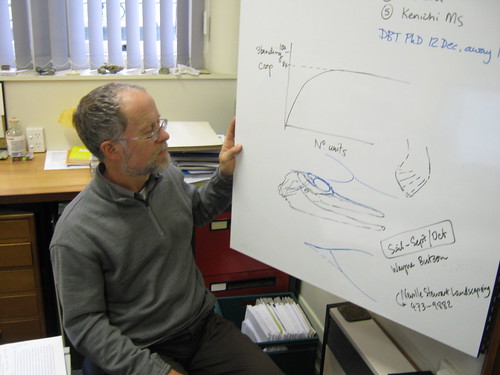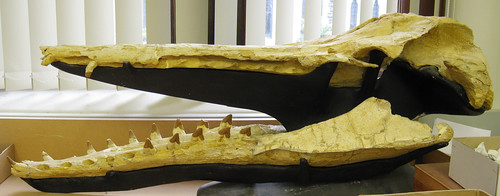 Craig brings you the next chapter of his...
Craig brings you the next chapter of his...
Flukes go on Whales... NOT in your Art!
Part: 4
Flukes of times past...
Now for Flukes of times present!
 So I'd managed to get my Squalodon looking something like a Dolphin should. Showing it to Dr. Fordyce I got my first passing grade on the restoration! It got a C- so to speak. All the details were wrong, but I'd gotten the general layout right. Which was a first!
So I'd managed to get my Squalodon looking something like a Dolphin should. Showing it to Dr. Fordyce I got my first passing grade on the restoration! It got a C- so to speak. All the details were wrong, but I'd gotten the general layout right. Which was a first!
However my set of renders were not overly helpful for Dr. Fordyce to go into the models details. Like this one above, all my renders were in a 3D environment, which I quickly learned weren't useful for critiques. I was going to need something better for the good doctor to look at...
 This is the format I came up with. A schematic of my Shark Toothed Dolphin from ever basic view available.
This is the format I came up with. A schematic of my Shark Toothed Dolphin from ever basic view available.
Rule #5 of Scientific Restorations: Before getting your piece reviewed by an expert make sure you prepare some easy to approach material for them to look at. If you can (or have the time to) make a schematic view of your creature. This allows the expert to look at preciously what you are doing in your restorations, and thus give you useful feedback.
Dr. Fordyce much preferred these to my original in water shots.

So with these modifications in mind I set off to work on upgrading my mark ;P
 By this point in late 2009 I had been making some big breakthroughs across the board in my 3Ding (in large part thanks to ART Evolved). I now had a better method of creating underwater effects, which I promptly plopped my Squalodon into.
By this point in late 2009 I had been making some big breakthroughs across the board in my 3Ding (in large part thanks to ART Evolved). I now had a better method of creating underwater effects, which I promptly plopped my Squalodon into. By now I also had a firm grasp on 3D rigging, so the Shark Toothed Dolphin became my first model to be rigged by a single skeleton! (I typically rig each part separately, and simply pose them relative to each other).
By now I also had a firm grasp on 3D rigging, so the Shark Toothed Dolphin became my first model to be rigged by a single skeleton! (I typically rig each part separately, and simply pose them relative to each other).Even before Dr. Fordyce's changes, my Squalodon was starting to look pretty sweet!

With the changes this is what it looked like. I hadn't managed to get in the neck folds Dr. Fordyce had wanted (and I still haven't...), but tried to tweak everything else.
I got a B. Which was huge for me. Still not publication worthy, but Dr. Fordyce was starting to believe he might want to use my Squalodon for his description!
I got a very cool anatomy lesson on the very precise details of how he thought these whales went together. From this point I was armed with the most up to date view on Squalodon ribs, flippers, and echo locating melon organ.

Before I took this version in to Dr. Fordyce I wanted to test out my than new direct fossil comparison technique. This was the second 3D model I tried it on.
So taking the skull above, I cut it out of this photo and than laid it over my model semi-transparent.

I was amazed to discover it was a perfect match! Through my hard manual work, and input from Dr. Fordyce, I'd modelled my Dolphin exactly in line with the fossil. Even most of the teeth were the same! Though I will never be waiting to the end of the modelling process to do this test ever again!!!
Showing it to Dr. Fordyce, I got the highest mark to date. An A-!!!
 Apart from the neck wrinkles and removing some of the model induced lines from the skull area, this Squalodon met with Dr. Fordyce's standards!
Apart from the neck wrinkles and removing some of the model induced lines from the skull area, this Squalodon met with Dr. Fordyce's standards! It was now time to develop a scene for this critter to steal!
It was now time to develop a scene for this critter to steal!
Building some test Penguins I toyed with updating the main picture of Squalodon used at the University of Otago. Sadly, Dr. Fordyce has asked me not to post this picture, but it is of two (older style) Squalodons chasing some of the giant penguins that lived alongside them.



